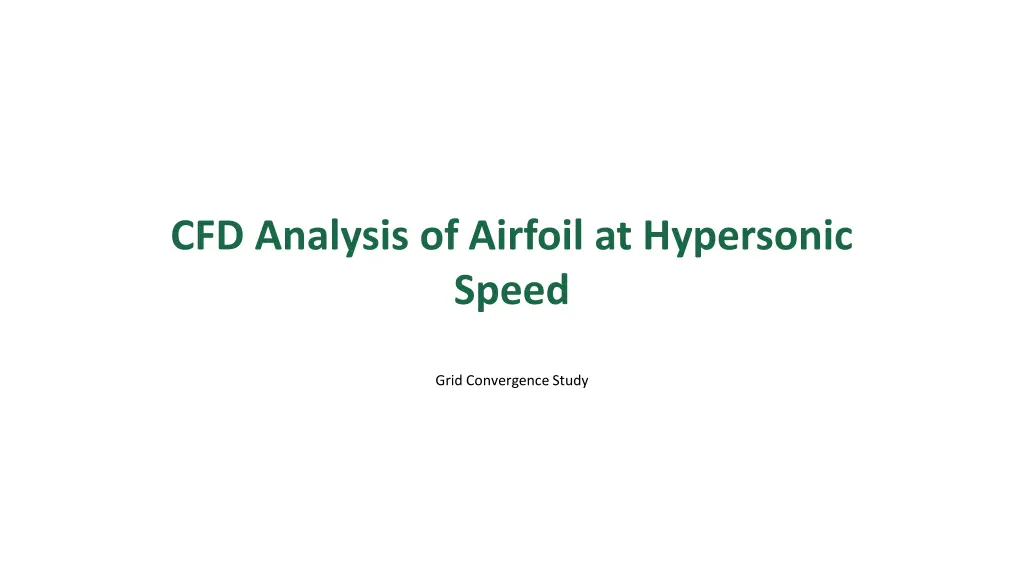
Hypersonic Airfoil CFD Analysis & NASA STI Program Insights
Explore a detailed CFD analysis of airfoil performance at hypersonic speeds, featuring a grid convergence study. Discover the role of the NASA STI Program in advancing aeronautics and space science through technical publications, memoranda, and contractor reports.
Download Presentation

Please find below an Image/Link to download the presentation.
The content on the website is provided AS IS for your information and personal use only. It may not be sold, licensed, or shared on other websites without obtaining consent from the author. If you encounter any issues during the download, it is possible that the publisher has removed the file from their server.
You are allowed to download the files provided on this website for personal or commercial use, subject to the condition that they are used lawfully. All files are the property of their respective owners.
The content on the website is provided AS IS for your information and personal use only. It may not be sold, licensed, or shared on other websites without obtaining consent from the author.
E N D
Presentation Transcript
CFD Analysis of Airfoil at Hypersonic Speed Grid Convergence Study
01 Introduction Table of Contents 02 NASA STI Program 03 Technical Publication 04 Technical Memorandum 05 Contractor Report 06 Conference Publication 07 Special Publication 08 Technical Translation 09 Conclusion 10 References
1 Introduction To determine the appropriate grid resolution limit for CFD analysis of airfoil at hypersonic speed. A grid resolution study was performedon a planar (2D) grid of the forward portion of the IMX inlet. Conducted by John W. Slater and John D. Saunders at Glenn Research Center, Cleveland, Ohio. Part of the Computational Fluid Dynamics (CFD) Simulation of Hypersonic Turbine-Based Combined-Cycle (TBCC) Inlet Mode Transition. Published in NASA/TM 2010-216362, May 2010, AIAA 2009 7349.
2 NASA STI Program Dedicated to the advancement of aeronautics and space science since its founding. Helps NASA maintain its role by collecting, organizing, and disseminating scientific and technical information. Provides access to the NASA Aeronautics and Space Database and the NASA Technical Reports Server. Results are published in both non-NASA channels and by NASA in the NASA STI Report Series. Includes Technical Publications, Technical Memorandums, Contractor Reports, Conference Publications, Special Publications, and Technical Translations.
3 Technical Publication Reports of completed research or significant phases of research with extensive data or theoretical analysis. Includes compilations of significant scientific and technical data deemed of continuing reference value. NASA counterpartof peer-reviewed formal professional papers with less stringentlimitations. Less stringentlimitations on manuscript length and extent of graphic presentations. Aimed at professionals seeking detailed and comprehensive research findings.
4 Technical Memorandum Scientific and technical findings that are preliminary or of specialized interest. Includes quick release reports, working papers, and bibliographies with minimal annotation. Does not contain extensive analysis, focusing on preliminaryfindings. Targeted at researchers and professionals needing quick access to preliminary data. Designed for rapid dissemination of findings to the scientific community.
5 Contractor Report Scientific and technical findings by NASA-sponsored contractors and grantees. Includes detailed reports on research conducted underNASA contracts. Reflects collaborative efforts between NASA and external researchers. Provides insights into specialized research areas supported by NASA. Intendedfor stakeholders and collaborators in NASA-sponsored projects.
6 Conference Publication Collected papers from scientific and technical conferences, symposia, and seminars. Includes diverse topics presentedat NASA-sponsored or co-sponsored events. Showcases collaborative research efforts and knowledge sharing. Aimed at conference attendees and the broaderscientific community. Facilitates the dissemination of cutting-edge research and developments.
7 Special Publication Scientific, technical, or historical information from NASA programs, projects, and missions. Focuses on subjects with substantial public interest and relevance. Intendedfor the general public and enthusiasts of space science. Enhances public understanding and appreciation of NASA's work. Presented in an accessible and engaging manner for a wide audience.
8 Technical Translation English-language translations of foreign scientific and technical materials. Includes translations of significant research findings and technical documents. Ensures global access to important scientific information. Facilitates international collaboration and knowledge exchange. Targeted at researchers and professionals seeking translated materials.
9 Conclusion Grid resolution study crucial for accurate CFD analysis of airfoils at hypersonic speeds. Contributes to the understanding of hypersonic flow dynamics and grid convergence. Potential for furtherresearch in 3D modeling and thermal effects. NASA's STI program plays a vital role in disseminating research findings. Encourages ongoing exploration and innovation in aeronautics and space science.
10 References John W. Slater and John D. Saunders, Glenn Research Center, Cleveland, Ohio. NASA/TM 2010-216362, May 2010, AIAA 2009 7349. Part of the Computational Fluid Dynamics (CFD) Simulation of Hypersonic Turbine-Based Combined-Cycle (TBCC) Inlet Mode Transition. Provides access to one of the largest collections of aeronautical and space science STI. Includes relevant papers and ANSYS manuals for furtherreading.
